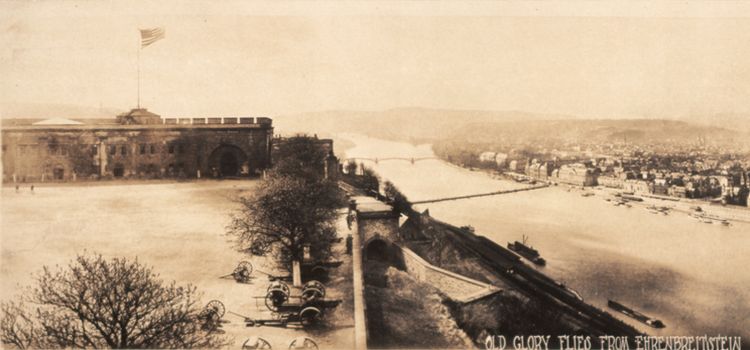
[Rhineland, 1922] Chiara and John left home for the United States, along with the majority of the AFG soldiers. General Allen prevented Ehrenbreitstein fortress from being destructed.
Most Americans, including President Harding, would have preferred to recall all American troops from the Rhine right away. They did not want the United States to get involved in an international conflict just because the League of Nations said so, and AFG soldiers should not be dragged into a conflict between French troops and German civilians.
General Allen
General Allen in Coblenz had been in command of the American Forces in Germany since July 8, 1919. Since May 21, 1920, he was the American representative on the Interallied Rhineland High Commission. For all his sympathy and compassion for France, its “military attitude” to hold Germany down for years greatly worried him, as it would rather bring about new conflicts and suffering than peace and reconstruction in Europe. For this reason, the AFG was playing a crucial stabilizing role. Firmly believing in the AFG’s mission, the General stood for continuing the U.S. deployment on the Rhine.
In April 1922, the new ambassador to Germany, Alanson B. Houghton, arrived at Coblenz and consulted the General. He saw the positive influence exercised by Allen and the AFG, and understood that recalling all American troops ran counter to the Republican objective of restoring world order. A compromise was found: although the AFG were reduced, some 1,000 soldiers would remain in Coblenz. Most likely, such a small contingent would not be engaged in fighting, yet the mere gesture of America’s ongoing involvement might calm the situation.
Departure
Eventually, in January 1923, Congress decided to reduce all American troops. A couple of days later, French and Belgian troops occupied the Ruhr area. On January 24, 1923, the American flag was lowered from the historic Fortress Ehrenbreitstein and the last American forces departed from Germany. General Allen gave his final speech, probably with worries: “With deep affection in our hearts for our Allies and sympathy for our former foes, our highest ambition has been to act with such justice towards all as would insure a lasting peace in Europe.”
The departing American soldiers took the blessings of many Germans with them. As an American officer wrote: “One could but reflect that the departing soldiers would probably meet with no such cordiality upon their arrival in their own country.” Unfortunately, the return of the last of the doughboys drew no acclaim in the United States.
Ambassador Houghton
Ambassador Houghton served in Germany from 1922 to 1925, so he witnessed the young republic’s year of crisis 1923 with the Ruhr occupation, passive resistance, hyperinflation and several coups. Having studied in prewar Berlin, the Ambassador wanted to restore friendly relations between the USA and Germany. He believed that world peace, European stability, and American prosperity depended upon a reconstruction of Europe’s economy and political systems. However, one had to find a way that the Allies could pay their debt to the United States, and Germany could pay its reparations to the Allies. Accordingly, he became a leading promoter of the Dawes Plan that greatly helped Germany’s economy to recover.
What became of our family?
The Twenties began to roar in Germany, and the Weimar Republic was granted a short time of economic recovery and political stability. Kathi and Max had a son and a daughter. They remained in close touch with Chiara and her family in the United States. The coats made from Chiara’s army cloth seemed to last forever.
But German democracy was shaky. Already in the middle of the twenties, the parties of the center and center-left lost many votes whereas the hardliners, even extremists on both sides grew stronger. In 1925, Reichspräsident Ebert died, and the Germans elected former general Paul von Hindenburg as his successor. Nevertheless, Chancelor Wilhelm Marx of the Center party did his best to keep democratic governments going, and foreign Minister Stresemann sought understanding with the former enemies.
The 1930s
On October 25, 1929, the stock exchange crash in New York widened into a world economic crisis and global depression. In Germany, the depression led to economic collapse, mass unemployment and pauperization. Already in March 1930, the acting grand coalition under Chancellor Hermann Müller (SPD) broke apart. In fact, the parliamentarian democracy had broken apart. Reichspräsident Hindenburg became more and more authoritarian. Moreover, the Reichstag elections of September 1930 resulted in the Nazi Party’s landslide breakthrough, and the greater the need, the more votes the extremistswon.In 1932, the Nazi Party and the Communist party were the strongest factions in the Reichstag. The Republic was about to crumble.
In 1932, a very worried Joscha Csabany travelled again to Germany, leaving his family tickets to the United States. Early in 1933, Max and Kathi, outspoken democrats, left Germany with their children.
1940s to 1960s
Kathi, the winemaker, helped rebuild the Mountain Men Vineyard after prohibition, Max worked with an American railroad company. Their children grew up in the United States and became US citizens. They always kept in touch with Germany, and the outbreak of World War II broke their hearts.
After the war, they went back to Germany to help rebuild their native country. And Lottie had saved a bottle of the “vintage of the century” 1921.
References
The photo is from the German Wikipedia, public domain section. The passages on Ambassador Houghton are from the Wikipedia too. As to General Allen, my source is Henry T. Allen, “My Rhineland Journal”.

Be the first to comment